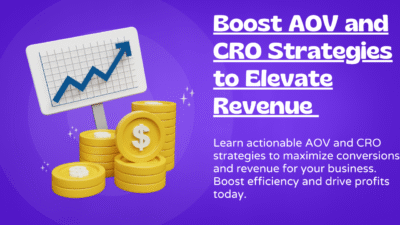Every business strives for one thing online – turning visitors into valued customers. Every click, scroll, or engagement on your site offers an opportunity to achieve this. However, without a solid strategy for conversion rate optimization (CRO), these opportunities often go unrealized.
Understanding Conversion Rate Optimization
So before delving into technique specifics why do not we first briefly understand just what CRO is?Conversion Rate Optimization which is the method of increasing the percentage of website visitors that take a desired action.These activities might vary from providing your email address, downloading an eBook or purchasing something. And documentation of success can go deep here : for example If you’ve succeeded is show them an ebook on how exactly to save money at home by putting insulation into walls properly then allow them access to that tutorial and some pictures too for good value.
To bettersimplify.CRO allows you increase effectiveness with your present traffic (instead of increasing adspends for better results).
In a rapid example your site gets 10,000 visitors a month and thecurrent conversion rate is 2%. However, after doubling that conversion rate to 4% same 10,000 visitors produce twice as many conversions as before.
Now that we’ve established its importance let’s examine the top strategies for boosting CRO.
Prioritize User Experience
Speed up your load time
Page speed is a make-or-break factor in CRO. Studies show that pages that take longer than three seconds to load see 53% of mobile users drop off. Optimize your load speed by:
- Compressing images
- Minimizing HTTP requests
- Utilizing browser caching
- Using content delivery networks (CDNs)
Mobile-first design is key
Over 50% of web traffic comes from mobile devices, so a poor mobile experience can cost you conversions. Ensure your mobile site is responsive, easy to read, and has simplified navigation.
Create intuitive navigation
Visitors should find what they need with minimal clicks. Use clear menus, categorized pages, and easily-accessible CTAs. Confusion can lead to abandonment, so aim for simplicity.
A/B Testing
Testing forms the core of CRO. A/B testing (or split testing) compares two versions of your webpage (e.g., different headlines or CTA button colors) to see which performs better.
What should you test?
- Headlines: Test different phrasing or tones to engage users.
- Call-to-Action Buttons: Experiment with placement, color, and text (e.g., “Get Started” vs. “Sign Up Now”).
- Landing Pages: Compare long-form vs. short-form content.
The key is to test one element at a time to determine its exact impact.
Use Social Proof
People trust what others endorse. Integrating social proof into your website is one of the most effective ways to build credibility and drive conversions.
Types of social proof to leverage
- Reviews and Testimonials: Prominently display customer opinion about your product or service.
- Trust Badges: Use certifications or security badges to reassure customers.
- Case Studies and Success Stories: Share real customer stories to highlight your product’s results.
For example, adding the phrase “4.9/5 stars from 2,000+ happy customers” can establish instant credibility.
Simplify Forms
Complex and lengthy forms can lead to friction. The simpler your forms, the better your chances of converting leads.
Strategies for better forms
- Reduce the number of fields to only what’s necessary.
- Use autofill options to save users time.
- Offer a progress bar for multi-step forms to reduce abandonment rates.
Leverage Personalization
Today’s users expect personalized experiences. With the right CRO tools and data, you can tailor your website to individual preferences.
How can you personalize effectively?
- Dynamic Content: Modify headlines and offers based on user location or browsing behavior.
- Behavior Triggers: Use exit-intent popups to provide special offers before users leave your site.
Personalization builds stronger connections and encourages visitors to stay on-site longer.
Optimize Your CTAs
Your Call-to-Action (CTA) buttons are arguably your site’s most essential element when it comes to conversions. They tell visitors what action to take, so their visibility and effectiveness are paramount.
Tips to create impactful CTAs
- Be action-oriented: Use words like “Discover,” “Try,” “Get,” or “Join.”
- Make them stand out: Contrasting colors and prominent placement are non-negotiables.
- Add urgency: Create FOMO by including phrases like “Limited Offer” or “Ends Today.”
Retargeting and Remarketing
Not all visitors convert on their first visit, but that doesn’t mean you’ve lost them forever.
Bring back lost visitors with retargeting
Retargeting ads allow you to re-engage users who’ve previously visited your site with personalized messages, discounts, or reminders. Tools like Google Ads or Facebook Retargeting are great for this purpose.
Engage repeat visitors
Email campaigns can nurture users who showed interest. Use drip emails or remarketing campaigns to guide old visitors down the conversion funnel.
Analyze Heatmaps
Heatmaps provide invaluable insights into how users interact with your site. You can visualize click patterns, scroll depth, and engagement to identify problem areas.
Use heatmap tools like Hotjar or Crazy Egg to refine your layout, improve CTAs, and reorganize content for better conversions.
Focus on Content Clarity
Content that confuses or overwhelms visitors can lead to drop-offs. Aim for concise headlines, easy-to-read fonts, and clearly articulated benefits.
Examples of clear content
- “Save time and money by automating your workflow” beats “Our software offers a variety of features that may improve productivity.”
- Break information into small paragraphs and use bullet points to improve readability.
Build Trust with Transparency
Today’s consumers are savvy and skeptical, so transparency matters more than even before.
Build trust through
- Clear Pricing: Hidden fees are a sure way to lose customers. Be honest and upfront.
- Privacy Policies: Make sure your site visibly states how user data is being used.
- Customer Support Access: Offer live chats, fast response emails, and support phone numbers.
Successful CRO is an Ongoing Process
CRO isn’t a set-it-and-forget-it task. It demands continual testing, iteration, and refinement to stay aligned with changing user expectations.
By implementing these top strategies, your business website can surpass average performance metrics and transform visitors into loyal customers.
Take Action to Streamline Conversions
Now that you know how to increase the conversion rate, it’s time to put those strategies in practice. Find the easiest improvements to make on your website, start with small risk A/B tests, and prioritize changes that will have a big impact.
Just remember, CRO doesn’t mean getting more traffic — it’s about every visit counting.





